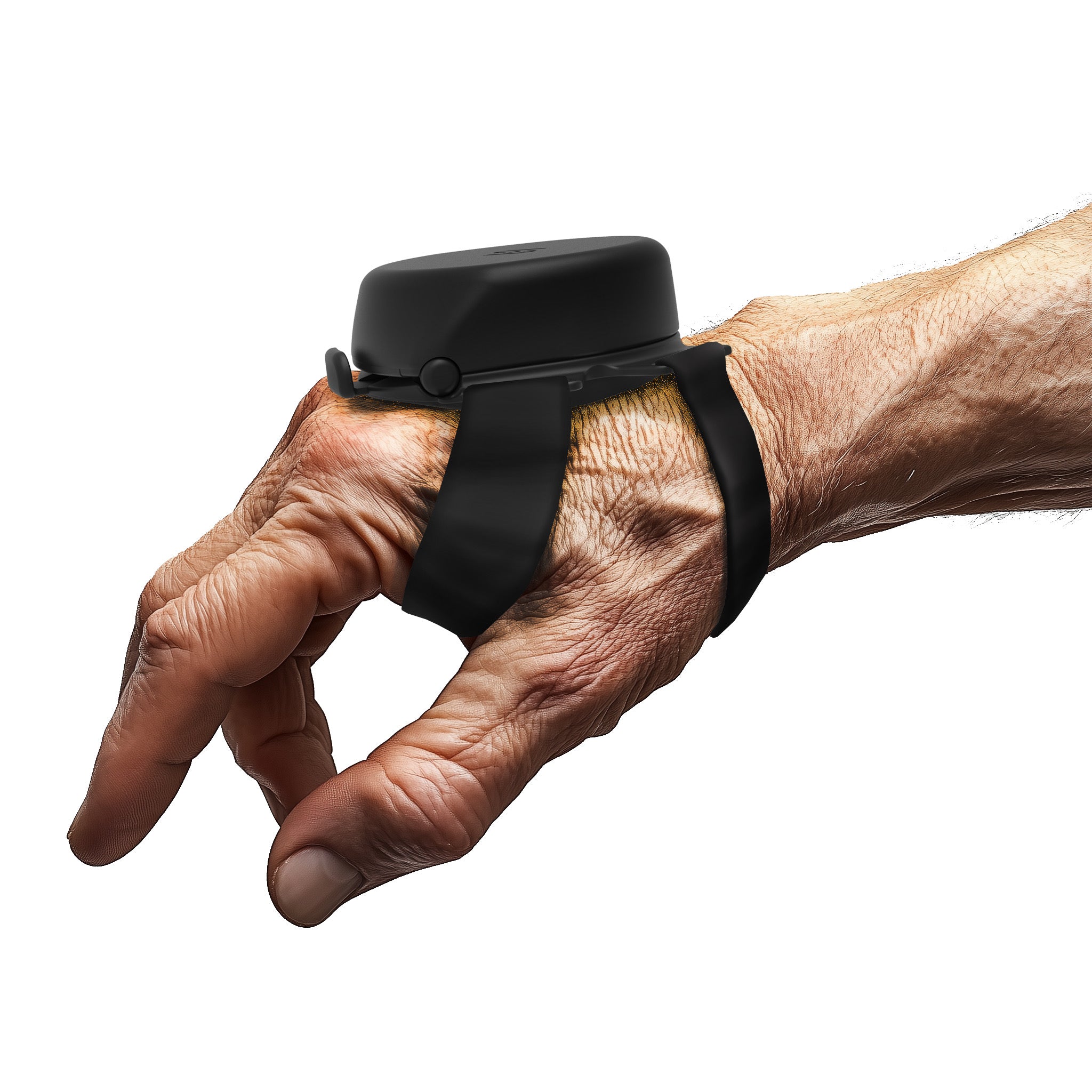Caught off guard by finger twitching or unexpected finger tremors? These involuntary movements can be unsettling and interfere with daily tasks. Understanding the difference between finger twitching causes and tremors helps you manage your symptoms and seek appropriate care.
This updated guide explains the reasons behind why is my index finger twitching, what it means when your pinky finger is twitching, when to see a doctor, and how innovative solutions like the Steadi-3 glove from Steadiwear can help you regain control and independence.
Always consult a qualified healthcare provider for personalized medical advice on managing tremors, Essential Tremor, or Parkinson's Disease.
Why is My Index Finger Twitching?
Several factors could be causing your index finger to twitch, including muscle strain, stress, dehydration, caffeine, and certain medications. While most cases are mild and temporary, if the twitching persists, it’s worth seeing a doctor to rule out anything more serious.
Caffeine affects the nervous system by blocking adenosine receptors in the brain, which leads to increased neuronal activity. This overstimulation can result in muscle spasms, including index finger twitching, particularly when caffeine is consumed in high amounts or over a prolonged period.
Medications, especially stimulants and diuretics, are also linked to muscle twitching. Stimulants enhance nervous system activity, potentially causing involuntary muscle movements, while diuretics can lead to dehydration and electrolyte imbalances, which further contribute to twitching.
Identifying the specific cause of finger twitching—excessive caffeine intake, dehydration, or medication side effects—can help individuals better manage and reduce twitching.
Why is My Index Finger Twitching at Rest?
Finger twitching at rest may suggest an underlying neurological condition, but mild occasional twitches at rest are common too. It is essential to distinguish between Essential Tremor and Parkinson’s Disease, as they manifest differently.
Essential Tremor is most noticeable during voluntary movement, such as writing or holding objects, and typically does not occur when the hands are completely relaxed. In contrast, a resting tremor is a hallmark symptom of Parkinson’s Disease. These tremors often appear when the hand rests and tend to subside during intentional movements.
Understanding why is my index finger twitching at rest is crucial for identifying the underlying condition and seeking appropriate medical advice. If twitching persists or worsens, consulting a neurologist is recommended for accurate diagnosis and treatment.
Why is My Finger Twitching?
Fatigue, stress, or too much caffeine are the most common reasons for finger twitching. Other factors, such as dehydration or nerve irritation, may also be involved. While these twitches are often harmless and disappear independently, prolonged twitching might indicate a nerve issue.
If you’ve ever wondered why is my index finger twitching, it’s often due to the same triggers—muscle fatigue, stress, or excess caffeine. However, when twitching becomes frequent or disruptive, consulting a doctor can help rule out more serious causes.
Check Out Essential tremor treatment options
Unraveling Finger Twitching Causes
There are several possible causes of finger twitching, ranging from everyday habits to underlying medical conditions. Below are some of the most common reasons why you might notice your pointer finger twitching, middle finger twitching, or even your pinky finger twitching. If you’ve ever wondered why is my index finger twitching, the answer often lies in these common triggers:
-
Caffeine
Caffeine stimulates the nervous system by blocking adenosine receptors, which increases neural activity. While this boost can improve alertness, too much caffeine may overstimulate muscles and cause finger twitching or muscle spasms, especially if consumed in large amounts daily. -
Physical Exercise
After intense exercise or repetitive hand use, small muscles in your fingers can become tired and overworked. This muscle fatigue can trigger finger twitching that usually goes away with rest. -
Fatigue
A lack of sleep can stress your nerves and muscles, sometimes leading to minor involuntary twitches. If you’re experiencing finger twitching at rest, getting more sleep may help resolve the issue. - Stress and Anxiety
High stress levels can overstimulate your nervous system, causing brief, harmless muscle twitches in your fingers. Managing stress and allowing your hands to rest often helps reduce twitching fingers.
Other Causes of Finger Twitching
Several additional finger twitching causes may be linked to medical conditions or deficiencies. If you’ve ever asked yourself why is my index finger twitching, it could sometimes point to factors beyond everyday stress or fatigue. Here are some key examples:
1. Vitamin Deficiencies
Low levels of specific vitamins—especially vitamin B12—can negatively impact nerve function, leading to occasional finger twitching or tingling sensations. Maintaining a balanced diet rich in essential nutrients can help reduce the risk of finger twitching due to deficiencies.
2. Medications
Some medications list finger twitching as a possible side effect. Stimulants, certain asthma medications, or diuretics can affect the nervous system or fluid balance, which might trigger twitching. Talk to your doctor if you experience new symptoms after starting or changing a prescription.
3. Amyotrophic Lateral Sclerosis (ALS):
Although very rare, ALS is a serious neurological condition that can cause muscle twitching (known medically as fasciculations). In ALS, twitching may progress to muscle weakness and difficulty with movement. However, isolated finger twitching without other symptoms is rarely due to ALS. If you have concerns, consult a neurologist for an accurate evaluation.
4. Essential Tremor
Essential Tremor is one of the most common movement disorders. It causes rhythmic, involuntary shaking, usually noticeable during voluntary activities like writing or holding objects. Unlike twitches, Essential Tremor causes a more consistent tremor during action rather than rest and often runs in families.
5. Parkinson’s Disease
Tremors are a hallmark sign of Parkinson’s Disease. They usually start subtly in the fingers or hands when at rest and may temporarily lessen during intentional movement. As the disease progresses, tremors can become more noticeable and may be accompanied by muscle stiffness and slower movement. If you notice a persistent finger tremor while your hand is at rest, seek medical advice for proper assessment.
Why Does My Thumb Twitch?
Thumb twitching can happen due to muscle fatigue, dehydration, stress, or repetitive overuse, such as frequent texting or typing. In most cases, it’s harmless and short-lived. However, if twitching persists or worsens, it could point to an underlying neurological condition or nutrient imbalance. In such cases, it’s best to consult a doctor for proper evaluation.
How the Steadi-3 Glove Can Help
The Steadi-3 glove from Steadiwear is a practical, science-backed management tool for individuals experiencing finger tremors. As a Class I medical device, it is designed to immediately stabilize trembling hands, helping users regain control and independence in daily activities. Its lightweight, battery-free design ensures long-term comfort and ease of use without the need for charging or complicated upkeep.
Unlike heavy or battery-dependent devices, the Steadi-3 leverages innovative passive stabilization mechanisms that adapt naturally to your hand’s movements. Whether you are managing Essential Tremor, Parkinson’s Disease-related tremors, or other hand-movement disorders such as thumb twitching or index finger twitching, the glove helps reduce the impact of tremors, making everyday actions like eating, writing, typing, or holding objects smoother and more manageable.
By minimizing tremor interference, the Steadi-3 glove allows individuals to maintain independence and reduce the daily frustrations that tremors often cause. Routine tasks such as drinking from a cup, signing documents, or coping with why is my index finger twitching concerns become easier, supporting a steadier lifestyle.
Conclusion
Finger twitches and tremors might seem like minor inconveniences, but understanding their causes is crucial for effective management. Twitches often stem from temporary factors such as fatigue, stress, or dehydration, while tremors may signal underlying neurological conditions that need proper attention.
If you’ve ever wondered why is my index finger twitching or noticed occasional thumb twitching, addressing lifestyle factors like hydration, balanced nutrition, and rest can often resolve these episodes. However, if symptoms persist or worsen, consult a qualified healthcare provider for an accurate diagnosis and tailored treatment plan.
Innovative tools like the Steadi-3 glove from Steadiwear offer practical support for managing chronic tremors. They help restore control and enhance daily independence, whether you’re dealing with index finger twitching, thumb spasms, or more consistent tremors. Taking proactive steps supports a healthier, more comfortable lifestyle.
Always consult a qualified healthcare provider for personalized medical advice about tremors, Essential Tremor, or Parkinson’s Disease.
Resources:
https://www.mayoclinic.org/symptoms/muscle-twitch/art-20044928
https://www.ninds.nih.gov/health-information/disorders/tremor
https://www.parkinson.org/Understanding-Parkinsons/Symptoms/Movement-Symptoms/Tremor
https://www.hopkinsmedicine.org/health/conditions-and-diseases/muscle-fasciculation
https://ods.od.nih.gov/factsheets/VitaminB12-Consumer/
https://www.steadiwear.com



